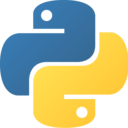
Python Programming Courses - Beginner
Learn the basics of Python programming
Python is a very versatile programming language and broad in its application. While Python can be used for everything from developing websites to programming robots, our courses focus on using Python for data analytics. Python has become popular as a general programming language because of its simplicity and power. It has also become very popular in the data science community and is a highly sought-after skill.
Python Programming Courses - Beginner

Learn the basics of Python programming for data analysis. Work in JupyterLab and Anaconda environments.
Frequently Asked Questions
Course Introduction
Our Python courses were designed by Tamara Shatar, who holds a PhD in Agricultural Data Science. She focused her extensive experience and skills in modelling using machine learning, simulation and other techniques to create a course with depth and applicability.
The course is consistently well reviewed by students.
"Very well presented and structured. Thank you for such a fruitful day." - Python Beginner, Sydney, Australia
What is Remote Training?
Remote training at Nexacu means our team of experienced trainers will deliver your training live online. With remote learning students can access our usual classroom training courses via video conferencing, ask questions, participate in discussion and share their screen with the trainer if they need help at any point. Students have the same level of participation and access to the trainer as they would in classroom training sessions.
What is Python?
Python is a general-purpose programming language that is easy to use and learn. It is open source and free to use, including for commercial use. The Python user community is very active. There are over 237,000 packages which have been contributed, which extend the functionality of the Python Standard Library. These packages contain functions to perform a wide range of tasks.
Python Programming Beginner Course Details


Python Programming Beginner Course Details


Python Programming Beginner Course Details


Python Programming Beginner Course Details


Python Programming Beginner Course Details


Python Programming Beginner Course Details


Python Course Outlines
Skills Test
Contact Us
What do I need to know to attend?
No specific pre-requisites for the course.
The course is aimed at those who are new to Python.
Python Programming Beginner Learning Outcomes
You will will be familiar with and competent in:
- Creating and managing environments in Anaconda
- Installing packages in conda environments
- Working in JupyterLab and with Jupyter Notebooks
- Creating basic markdown files
- Creating and manipulate objects
- Using functions and methods
- Creating basic data visualizations
Python Programming Beginner Course Content
- Introduction
- Introduction to Python
- Introduction to Anaconda and JupyterLab
- The Python Standard Library
- Installing Python
- Anaconda
- JupyterLab
- Installing additional packages
- Anaconda and JupyterLab
- Using Anaconda
- Working with environments
- Launching JupyterLab
- Working in JupyterLab
- Using Jupyter Notebooks
- Basics of running code
- Markdown
- Shutting down kernels and the Jupyter Server
- Using Python as a Calculator
- Arithmetic operators
- Relational operators
- Logical operators
- The Python Standard Library
- Built-in functions
- Other functions in the standard library
- Working with Objects
- Objects in Python
- What are objects?
- Creating variables
- Naming rules
- Naming conventions for variables
- Data Types and Structures
- Built-in data types
- Built-in data structures
- Tuples, lists, ranges and dictionaries
- Pandas Series and DataFrames
- Which data structure should I use?
- Pandas DataFrame
- Attributes
- Methods
- Pandas functions
- Creating DataFrames
- Importing data into a DataFrame
- Uploading data in JupyterLab
- Accessing data within DataFrames
- Accessing specific rows
- Accessing specific columns
- Accessing data subsets by name or position
- Manipulating DataFrames
- Making changes in place
- Renaming columns and rows
- Replace a single value
- Replace multiple values
- Add data to a DataFrame
- Remove rows or columns
- Filter based on condition
- Sort data
- Working with data in DataFrames
- Calculating summary statistics
- Evaluation in Python
- Order of operations
- Evaluation with Numpy
- Vectorized arithmetic
- Vectorized functions
- Broadcasting
- Creating new columns with vectorized arithmetic and functions
- Functions vs Methods
- What is a function?
- Syntax for using functions in Python
- Syntax for using methods in Python
- Parameters and arguments
- Getting help with a function
- Overview of help documentation
- Exporting Data
- Export data to csv file
- Basic Data Visualization
- Matplotlib
- Create a scatterplot
- Create a linechart
- Add text
- Add a legend
- Exporting plots
- Notebook to Markdown
- View your completed Notebook as a rendered Markdown file
 Australia
Australia
 New Zealand
New Zealand
 Singapore
Singapore
 Hong Kong
Hong Kong
 Malaysia
Malaysia
 Philippines
Philippines
 Thailand
Thailand
 Indonesia
Indonesia

 phone
phone
 email
email
 enquiry
enquiry
























